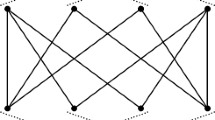Abstract
It is known that any self-dual Boolean function can be decomposed into compositions of 3-bit majority functions. In this paper, we define a notion of a ternary majority formula, which is a ternary tree composed of nodes labeled by 3-bit majority functions and leaves labeled by literals. We study their complexity in terms of formula size. In particular, we prove upper and lower bounds for ternary majority formula size of several Boolean functions. To devise a general method to prove the ternary majority formula size lower bounds, we give an upper bound for the largest separation between ternary majority formula size and DeMorgan formula size.
Access this chapter
Tax calculation will be finalised at checkout
Purchases are for personal use only
Preview
Unable to display preview. Download preview PDF.
Similar content being viewed by others
References
Andreev, A.E.: On a method for obtaining more than quadratic effective lower bounds for the complexity of π-scheme. Moscow University Mathematics Bulletin 42(1), 63–66 (1987)
Bioch, J.C., Ibaraki, T.: Decompositions of positive self-dual boolean functions. Discrete Mathematics 140(1-3), 23–46 (1995)
Böhler, E., Creignou, N., Reith, S., Vollmer, H.: Playing with boolean blocks, part I: Post’s lattice with applications to complexity theory. ACM SIGACT News 34(4), 38–52 (2003)
Chockler, H., Zwick, U.: Which bases admit non-trivial shrinkage of formulae? Computational Complexity 10(1), 28–40 (2001)
Fischer, M.J., Meyer, A.R., Paterson, M.S.: Ω(n log n) lower bounds on length of Boolean formulas. SIAM Journal on Computing 11(3), 416–427 (1982)
Håstad, J.: The shrinkage exponent of De Morgan formulas is 2. SIAM Journal on Computing 27(1), 48–64 (1998)
Hrubeš, P., Jukna, S., Kulikov, A., Pudlák, P.: On convex complexity measures. Theoretical Computer Science 411, 1842–1854 (2010)
Ibaraki, T., Kameda, T.: A theory of coteries: Mutual exclusion in distributed systems. IEEE Transactions on Parallel and Distributed Computing PDS-4(7), 779–794 (1993)
Karchmer, M., Kushilevitz, E., Nisan, N.: Fractional covers and communication complexity. SIAM Journal on Discrete Mathematics 8(1), 76–92 (1995)
Khrapchenko, V.M.: Complexity of the realization of a linear function in the case of π-circuits. Mathematical Notes 9, 21–23 (1971)
Laplante, S., Lee, T., Szegedy, M.: The quantum adversary method and classical formula size lower bounds. Computational Complexity 15(2), 163–196 (2006)
Lee, T.: A New Rank Technique for Formula Size Lower Bounds. In: Thomas, W., Weil, P. (eds.) STACS 2007. LNCS, vol. 4393, pp. 145–156. Springer, Heidelberg (2007)
Neciporuk, E.I.: A boolean function. DOKLADY: Russian Academy of Sciences Doklady. Mathematics (formerly Soviet Mathematics–Doklady) 7, 999–1000 (1966)
Paterson, M.S., Pippenger, N., Zwick, U.: Optimal carry save networks. In: Boolean Function Complexity. London Mathematical Society Lecture Note Series, vol. 169, pp. 174–201. Cambridge University Press (1992)
Paterson, M.S., Zwick, U.: Shallow circuits and concise formulae for multiple addition and multiplication. Computational Complexity 3(3), 262–291 (1993)
Post, E.L.: The two-valued iterative systems of mathematical logic. Annals Mathematical Studies, vol. 5. Princeton University Press (1941)
Pratt, V.R.: The effect of basis on size of Boolean expressions. In: Proceedings of the 16th Annual Symposium on Foundations of Computer Science (FOCS 1975), October 13-15, pp. 119–121. IEEE (1975)
Valiant, L.G.: Short monotone formulae for the majority function. Journal of Algorithms 5(3), 363–366 (1984)
Author information
Authors and Affiliations
Editor information
Editors and Affiliations
Rights and permissions
Copyright information
© 2012 Springer-Verlag Berlin Heidelberg
About this paper
Cite this paper
Ueno, K. (2012). Formula Complexity of Ternary Majorities. In: Gudmundsson, J., Mestre, J., Viglas, T. (eds) Computing and Combinatorics. COCOON 2012. Lecture Notes in Computer Science, vol 7434. Springer, Berlin, Heidelberg. https://doi.org/10.1007/978-3-642-32241-9_37
Download citation
DOI: https://doi.org/10.1007/978-3-642-32241-9_37
Publisher Name: Springer, Berlin, Heidelberg
Print ISBN: 978-3-642-32240-2
Online ISBN: 978-3-642-32241-9
eBook Packages: Computer ScienceComputer Science (R0)



